A New Species of the Asia n Toad Genus Megophrys sensu lato(Anura:Megophryidae) from Guizhou Province,China
2020-04-21JingLIUShizeLIGangWEINingXUYanlinCHENGBinWANGandJunWU
Jing LIU,Shize LI, ,Gang WEI,Ning XU,Yanlin CHENG,Bin WANG, and Jun WU*
1 Department of Resources and Environment,Moutai Institute,Renhuai 564500,China
2 Nanjing Institute of Environmental Sciences,Ministry of Ecology and Environment of China,Nanjing 210042,China
3 Biodiversity Conservation Key Laboratory,Guiyang College,Guiyang 550002,China
4 Chengdu Institute of Biology,Chinese Academy of Sciences,Chengdu 610041,China
Abstract We describe a new species of the genus Megophrys from Guizhou Province,China.Molecular phylogenetic analyses based on mitochondrial DNA and nuclear DNA sequences all strongly supported the new species as an independent clade nested into the Megophrys clade and sister to M.minor.On morphology,the new species is distinguished from its congeners by a combination of the following characters:(1) small body size with SVL < 39.2 mm in male and SVL < 40.4 mm in female;(2) vomerine teeth absent;(3) tongue not notched behind;(4) a small horn-like tubercle at the edge of each upper eyelid;(5) tympanum distinctly visible,rounded;(6) two or three metacarpal tubercles in hand;(7) relative finger lengths:I < II < V < III;(8) toes without webbing;(9) heels overlapped when thighs are positioned at right angles to the body;(10) tibiotarsal articulation reaching tympanum to eye when leg stretched forward;(11) an internal single subgular vocal sac in male;(12) in breeding male,the nuptial pads with black nuptial spines on the dorsal bases of the first and second fingers.
Keywords Taxonomy,new species,molecular phylogenetic analysis,morphology,China
1.Introduction
The Asian Horned toads of the subfamily Megophryinae(Amphibia:Anura:Megophryidae) is widely distributed in tropical and subtropical regions of Asia from India and Bhutan to China and south to the Sundas and the Philippines (Feiet al.,2012;Frost,2019).Taxonomic assignments especially generic arrangements in the group have been controversial (Dubois,1986;Dubois and Ohler,1998;Lathrop,1997;Tian and Hu,1983;Feiet al.,2009;Feiet al.,2012).Feiet al.(2016) classified 36 Chinese species of the subfamily Megophryinae into six genera,i.e.LiuophrysFei,Ye and Jiang,2016,AtympanophrysTian and Hu,1983 containing three subgenera (Atympanophrys,BorealophrysFei,Ye and Jiang,2016 andGigantophrysFei,Ye and Jiang,2016),BoulenophrysFei,Ye and Jiang,2016,XenophrysGünther,1864 containing two subgenera (TianophrysFei and Ye,2016 andXenophrys),OphyrophryneBoulenger,1908 andBrachytarsophrysTian and Hu,1983.Chenet al.(2017) classified the Asian horned toads into the generaAtympanophrys,MegophrysKuhl and Van Hasselt,1822 andXenophrys,Ophyrophryne,andBrachytarsophrys.Mahonyet al.(2017) classified all members of Megophryinae into a single genusMegophrys sensu latoincluding seven subgenera (Megophrys,Xenophrys,PanophrysRao and Yang,1997,Atympanophrys,Ophyrophryne,PelobatrachusBeddard,1908“1907”andBrachytarsophrys) based on molecular phylogenetics and morphological comparisons.
Megophryss.l.currently contains 91 species (Frost,2019),and as note,of which,37 species were described in the last decade(Deutiet al.,2017;Feiet al.,2009;Liet al.,2014;Liet al.,2018a;Mahony,2011;Mahonyet al.,2011;Mahonyet al.,2013;Mahonyet al.,2017;Mahonyet al.,2018;Messengeret al.,2019;Moet al.,2010;Muniret al.,2018;Orlovet al.,2015;Tapleyet al.,2017;Tapleyet al.,2018;Wanget al.,2012;Wanget al.,2014;Wanget al.,2017a,b;Wanget al.,2019;Yanget al.,2018;Zhanget al.,2017;Zhaoet al.,2014).What’s more,molecular phylogenetic studies still surprisingly indicated mass of cryptic species in the group,for example,20 cryptic species were suggested by Chenet al.(2017),and 41 cryptic species were proposed just only in subgenusMegophrys(Panophrys) by Liuet al.(2018).Obviously,detailed investigations need to be conducted for describing the cryptic species.
During field surveys in the Kuankuoshui National Nature Reserve,Suiyang County,Guizhou Province,China and Fanjing Mountain,Jiangkou County,Guizhou Province,China,we collected someMegophryss.l.specimens from the montane forests.Our molecular phylogenetic analyses and morphological comparisons indicated it as a new taxon ofMegophrys s.l.Herein,we describe it as a new species.
2.Materials and Methods
2.1.SpecimenTwo adult females and nine adult males of the new taxon (for voucher numbers see Table S1) were collected from the mountain streams in the Kuankuoshui National Nature Reserve,Suiyang County,Guizhou Province,China and Fanjing Mountain,Jiangkou County,Guizhou Province,China(Figure 1).Two tadpoles (voucher numbers:CIBKKS20180426001 and CIBKKS20180426002) of the new taxon were also collected in a mountain stream where the new taxon was found in the Kuankuoshui National Nature Reserve.They were identified as the new taxon because they were almost identical in morphology and one representative of them was genetically close to the adult specimens of the new taxon (see the results).The stages of tadpoles were identified following Gosner (1960).All specimens were fixed in 10% buffered formalin for one day,and then later transferred to 70% ethanol.Tissue samples were taken and preserved separately in 95% ethanol prior to fixation.The specimens were deposited in Chengdu Institute of Biology,Chinese Academy of Sciences (CIB,CAS).
2.2.Molecular data and phylogenetic analysesFour adult specimens and one tadpole of the new taxon were included in molecular analyses (for voucher information see Table 1).Total DNA was extracted using a standard phenol-chloroform extraction protocol (Sambrooket al.,1989).Two fragments of the mitochondrial genes encoding 16S rRNA and cytochrome oxidase subunit I (COI) were amplified using the primers in Simonet al.(1994) and Cheet al.(2012),respectively.They were amplified under the following conditions:35 cycles at 95 °C for 4 min,95 °C for 1 min,52 °C (for 16S rRNA)/46 °C (for COI) for 40 s,and 72 °C for 1 min followed by a 10 min extension at 72 °C.The nuclear gene fragments encoding brain-derived neurotrophic factor (BDNF) and recombination activating gene 1 (RAG1) were amplified using the primers and protocols in Vieiteset al.(2007) and Shenet al.(2013).All primers were presented in Table S2.PCR products were purified with spin columns and then were sequenced with primers same used in PCR.Sequencing was conducted using an ABI3730 automated DNA sequencer in Shanghai DNA BioTechnologies Co.,Ltd.(Shanghai,China).All sequences were deposited in GenBank (for GenBank accession numbers see Table 1).
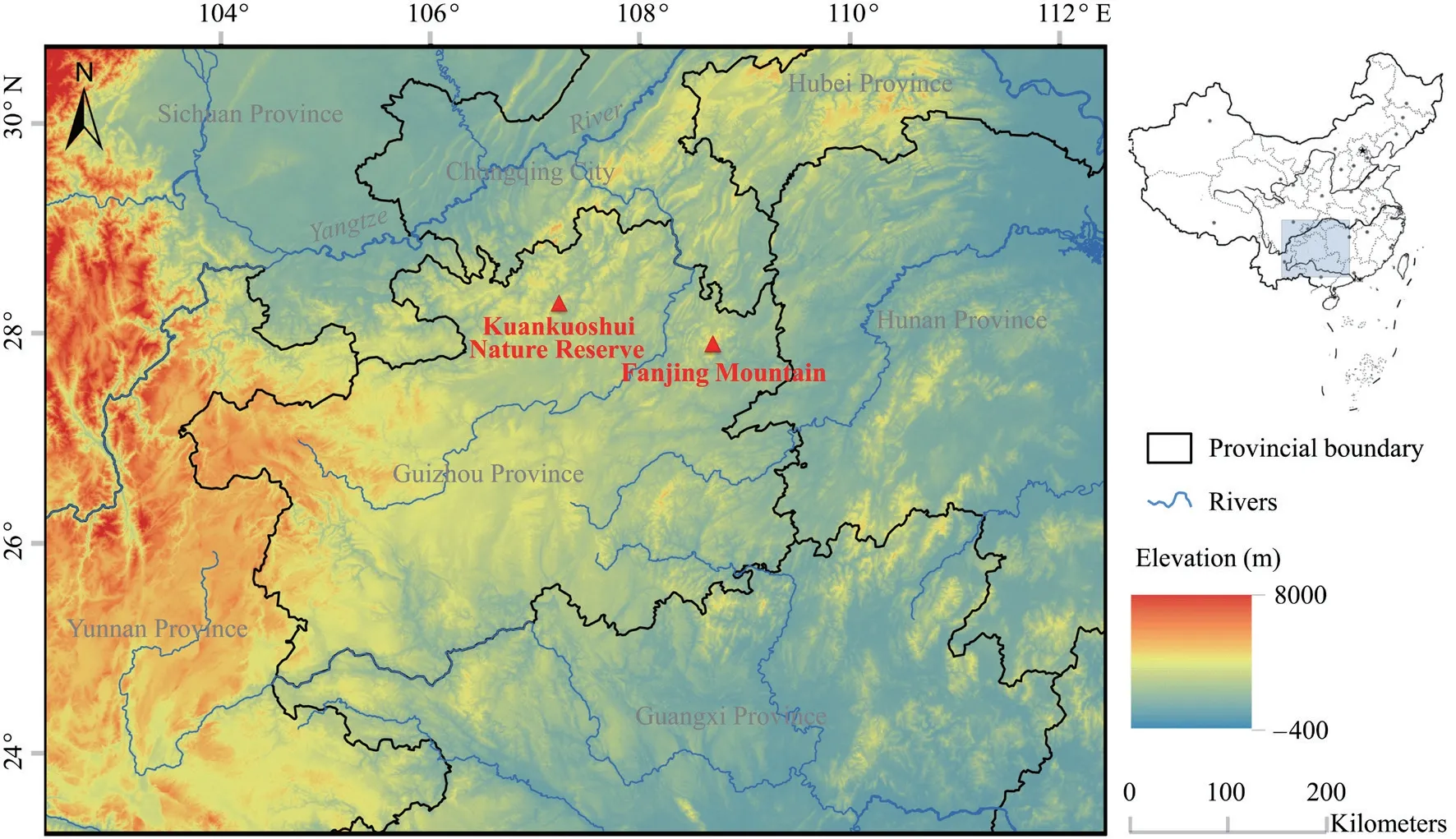
Figure 1 Sampling localities of Megophrys jiangi sp.nov.in this study.The type locality is Kuankuoshui National Nature Reserve,Suiyang County,Guizhou Province,China and another locality is Fanjing Mountain,Jiangkou County,Guizhou Province,China.

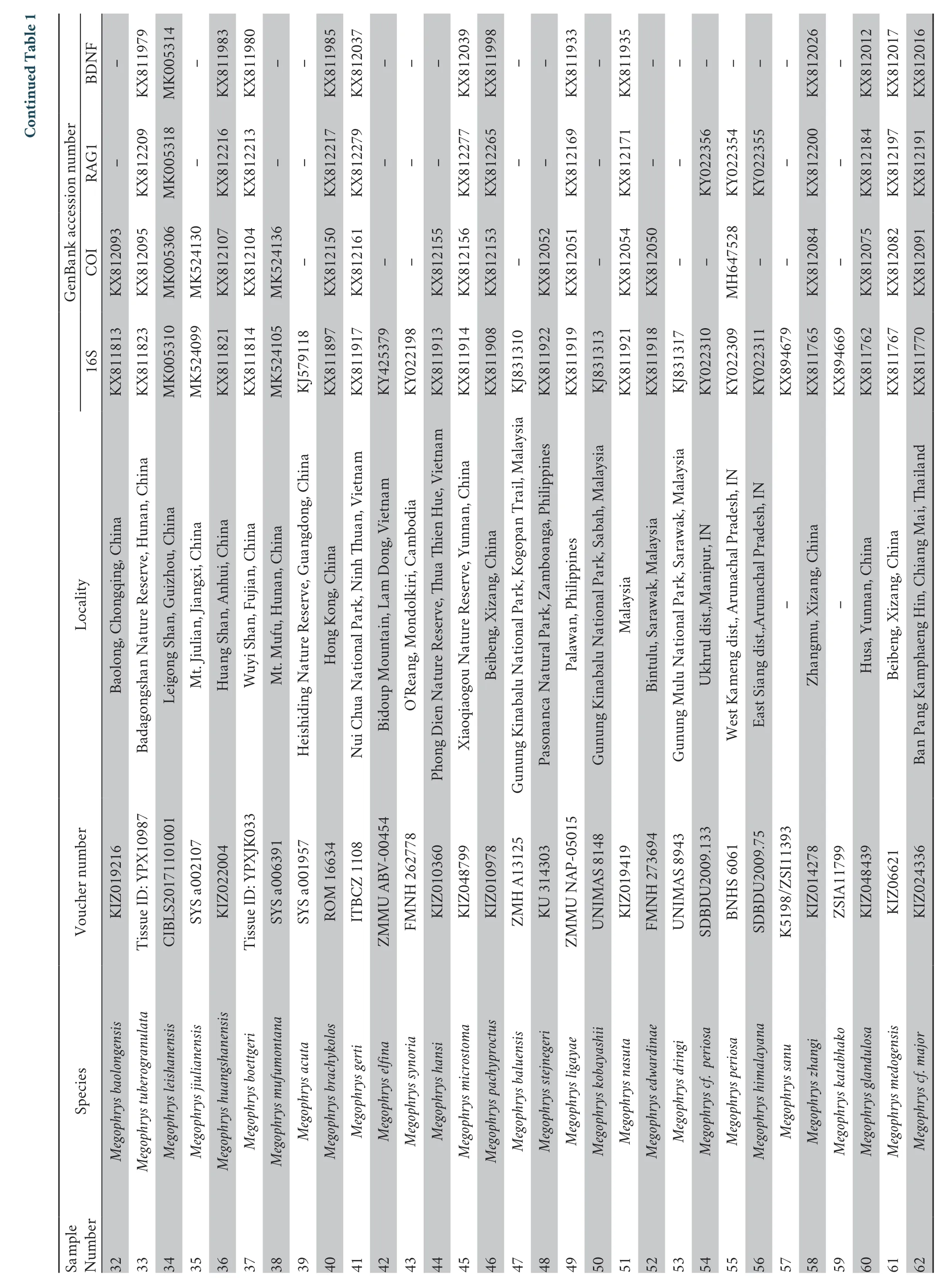

For molecular analyses,the available sequence data for all related species of the genusMegophryss.l.were downloaded from GenBank,primarily from previous studies (Chenet al.,2017;Liuet al.,2018;for GenBank accession numbers see Table 1).For phylogenetic analyses,corresponding sequences of oneLeptolalax oshanensisand oneLeptobrachium boringiiwere downloaded (for GenBank accession numbers see Table 1) and used as outgroups according to Chenet al.(2017).
Sequences were assembled and aligned using the Clustalw module in BioEdit 7.0.9.0 (Hall,1999) with default settings.Alignments were checked by eye and revised manually if necessary.To avoid bias in alignments,GBLOCKS 0.91.b(Castresana,2000) with default settings was used to extract regions of defined sequence conservation from the lengthvariable 16S gene fragments.Non-sequenced fragments were defined as missing loci.
Phylogenetic trees were reconstructed for the mitochondrial genes concatenated data and nuclear genes concatenated data,respectively.Phylogenetic analyses were conducted using maximum likelihood (ML) and Bayesian Inference (BI)methods,implemented in PhyML 3.0 (Guindonet al.,2010) and MrBayes 3.12 (Ronquist and Huelsenbeck,2003),respectively.To avoid under-or over-parameterization (Lemmon and Moriarty,2004;McGuireet al.,2007),the best partition scheme and the best evolutionary model for each partition were chosen for the phylogenetic analyses using PARTITIONFINDER 1.1.1(Robertet al.,2012).In the analyses,16S,each codon position of the protein-coding genes were defined,and Bayesian Inference Criteria (BIC) was used.As a result,the analyses selected the best partition scheme (i.e.16S gene/each codon position of COI gene)and the TrN+I+G model for each partition for mitochondrial DNA dataset,and as well,selected the best partition scheme(i.e.each codon position of RAG1 and BDNF genes) and the TrN+I+G as the best model for the second codon position of nuclear genes and the GTR+G +I model as the best model for the other two codon position of RAG1 and BDNF genes.For the ML tree,branch supports were drawn from 10 000 nonparametric bootstrap replicates.In BI analyses,two runs each with four Markov chains were run for 60 million generations with sampling every 1000 generations.The first 25% of generations were removed as the“burn-in”stage followed by calculation of Bayesian posterior probabilities and the 50%majority-rule consensus of the post burn-in trees sampled at stationarity.Finally,pairwise 16S and COI gene sequence divergence with uncorrectedp-distance model was estimated using MEGA 6.06 (Tamuraet al.,2011) to determine the genetic distance betweenMegophrysspecies,respectively.
2.3.Morphological comparisonsAll twelve adult specimens and six tadpole specimens of the new taxon collected in this work were measured.The terminology and methods followed Feiet al.(2009).Measurements were taken with a dial caliper to 0.1 mm.Nineteen morphometric characters of adult specimens were measured:SVL=snout-vent length (distance from the tip of the snout to the posterior edge of the vent),HDL=head length(distance from the tip of the snout to the articulation of jaw),HDW=maximum head width (greatest width between the left and right articulations of jaw),SL=snout length (distance from the tip of the snout to the anterior corner of the eye),ED=eye diameter (distance from the anterior corner to the posterior corner of the eye),IOD=interorbital distance (minimum distance between the inner edges of the upper eyelids),IND=internasal distance (minimum distance between the inner margins of the external nares),TYD=maximal tympanum diameter,LAL=length of lower arm and hand (distance from the elbow to the distal end of the Finger IV),LW=lower arm width (maximum width of the lower arm),FIL=first finger length (distance from base to tip of finger I),FIIL=second finger length (distance from base to tip of finger II);FIIIL=third finger length (distance from base to tip of finger III),FIVL=fourth finger length(distance from base to tip of finger IV),THL=thigh length (distance from vent to knee),TL=tibia length (distance from knee to tarsus),TW=maximal tibia width,TFL=length of foot and tarsus (distance from the tibiotarsal articulation to the distal end of the Toe IV),FL=foot length (distance from tarsus to the tip of fourth toe).A total of ten morphometric characters of tadpoles were measured:TOL=total length,SVL=snoutvent length,BH=maximum body height,BW=maximum body width,SL=snout length (distance from the anterior corner of the eye to the tip of the snout),SS=snout to spiraculum (distance from spiraculum to the tip of the snout),MW=mouth width(distance between two corners of mouth),IOD=interorbital distance (minimum distance between eyes),TAL=tail length(distance from base of vent to the tip of tail),TH=tail height(maximum height between upper and lower edges of tail).
We compared morphological characters of the new taxon with otherMegophrys s.l.species.Comparative data were obtained from the literature forM.aceras(Boulenger,1903),M.actuta(Liet al.,2014),M.ancrae(Mahonyet al.,2013),M.auralensis(Ohleret al.,2002),M.baluensis(Boulenger,1899a),M.baolongensis(Yeet al.,2007),M.binchuanensis(Ye and Fei,1995),M.binlingensis(Feiet al.,2009),M.boettgeri(Boulenger,1899b),M.brachykolos(Inger and Romer,1961),M.carinense(Boulenger,1889),M.caudoprocta(Shen,1994),M.cheni(Wanget al.,2014),M.chuannanensis(Feiet al.,2001),M.damrei(Mahony,2011),M.daweimontis(Rao and Yang,1997),M.dongguanensis(Wanget al.,2019),M.dringi(Ingeret al.,1995),M.edwardinae(Inger,1989),M.elfina(Poyarkovet al.,2017),M.fansipanensis(Taplyet al.,2018),M.feae(Boulenger,1887),M.feii(Yanget al.,2018),M.flavipunctata(Mahonyet al.,2018),M.gerti(Ohler,2003),M.gigantica(Liuet al.,1960),M.glandulosa(Feiet al.,1990),M.hansi(Ohler,2003),M.himalayana(Mahonyet al.,2018),M.hoanglienensis(Taplyet al.,2018),M.huangshanensis(Fei and Ye,2005),M.insularis(Wanget al.,2017a),M.intermedia(Smith,1921),M.jingdongensis(Fei and Ye,1983),M.jinggangensis(Wanget al.,2012),M.jiulianensis(Wanget al.,2019),M.kobayashii(Malkmus and Matsui,1997),M.koui(Mahonyet al.,2017),M.kuatunensis(Pope,1929),M.lancip(Muniret al.,2018),M.latidactyla(Orlovet al.,2015),M.leishanensis(Liet al.,2018a),M.lekaguli(Stuartet al.,2006),M.liboensis(Zhanget al.,2017),M.ligayae(Taylor,1920),M.lini(Wanget al.,2014),M.lishuiensis(Wanget al.,2017b),M.longipes(Boulenger,1886),M.major(Boulenger,1908),M.mangshanensis(Feiet al.,1990),M.maosonensis(Bourret,1937),M.medogensis(Feiet al.,1983),M.megacephala(Mahonyet al.,2011),M.microstoma(Boulenger,1903),M.minor(Stejneger,1926),M.montana(Kuhl and Van Hasselt,1822),M.monticola(Günther,1864),M.mufumotana(Wanget al.,2019),M.nankiangensis(Huet al.,1966),M.nankunensis(Wanget al.,2019),M.nanlingensis(Wanget al.,2019),M.nasuta(Schlegel,1958),M.obesa(Liet al.,2014),M.ombrophila(Messengeret al.,2019),M.omeimontis(Liu,1950),M.oreocrypta(Mahonyet al.,2018),M.oropedion(Mahonyet al.,2013),M.pachyproctus(Huang and Fei,1981),M.palpebralespinosa(Bourret,1937),M.parallela(Inger and Iskandar,2005),M.parva(Boulenger,1893),M.periosa(Mahonyet al.,2018),M.popei(Zhaoet al.,2014),M.robusta(Mahonyet al.,2013),M.rubrimera(Tapleyet al.,2017),M.sangzhiensis(Jianget al.,2008),M.serchhipii(Mathew and Sen,2007),M.shapingensis(Liu,1950),M.shuichengensis(Tian and Sun,2000),M.spinata(Huet al.,1973),M.stejnegeri(Taylor,1920),M.synoria(Stuartet al.,2006),M.takensis(Mahony,2011),M.tuberogranulata(Moet al.,2010),M.vegrandis(Mahonyet al.,2013),M.wawuensis(Feiet al.,2001),M.wugongshanensis(Wanget al.,2019),M.wuliangshanensis(Ye and Fei,1995),M.wushanensis(Ye and Fei,1995),M.zhangi(Ye and Fei,1992) andM.zunhebotoensis(Mathew and Sen,2007).
2.4.Bioacoustics analysesTen advertisement calls of one individual (specimen CIBKKS20180722006) of the new taxon were recorded at ambient air temperature of 19.5 °C and air humidity of 85% in a mountain stream of Kuankuoshui National Nature Reserve between 22:00-23:00 on 22 July 2018.SONY PCM-D50 digital sound recorder was used to record within 20 cm of the calling individuals.The sound files in wave format were resampled at 48 kHz with sampling depth 24 bits.The sonograms and waveforms were generated by WaveSurfer software (Sjöander and Beskow,2000) from which all parameters and characters were measured.Ambient temperature was taken by a digital hygrothermograph.
3.Results
3.1.Phylogenetic analysesAligned sequence matrix of 16S+COI and RAG1+BDNF contained 1101 bp and 1614 bp,respectively.ML and BI trees of the mitochondrial DNA dataset presented almost consistent topology (Figure 2A),and as well,ML and BI trees of the nuclear DNA dataset showed almost identical topology (Figure 2B),though relationships of several lineages were unresolved.All phylogenetic analyses strongly supported the new taxon as an independent clade nested into theMegophryss.l.clade and sister toM.minor.
Genetic distance on 16S and COI genes with uncorrectedp-distance model between samples of the new taxon are less than 0.2%,much lower than interspecific genetic distances in the genusMegophryss.l.(Tables S3 and S4).Genetic distance between the new taxon and its closely-related speciesM.minoris 8.3% on COI and 7.3% on 16S,being much higher than that between many pairs of closely related species in the genus,for example,on COI,M.huangshanensisvs.M.boettgeri(1.8%),M.sangzhiensisvs.M.spinata(3.8%),M.spinatavs.M.binlingensis(7.7%),M.sangzhiensisvs.M.binlingensis(6.8%) andM.wushanensisvs.M.tuberogranulata(7.0%);and on 16S,M.sangzhiensisvs.M.spinata(1.7%),M.spinatavs.M.binlingensis(1.7%) andM.minorvs.M.spinata(6.0%).
3.2.Description of the new species
Megophrys jiangi sp.nov.
HolotypeCIBKKS20180722006 (Figure 3),adult male,from Kuankuoshui National Nature Reserve (28°13′14″ N,107°09′47″E,1521 m a.s.l.),Suiyang County,Guizhou Province,China,collected by Shize LI on 22 July 2018.
Paratypethree adult males and one adult females from Kuankuoshui National Nature Reserve,Suiyang County,Guizhou Province,China,collected by Shize LI and Jing LIU.One female CIBKKS20180723003 collected by Jing LIU on 23 July 2018,three adult males CIBKKS20180723001,CIBKKS20180723002 and CIBKKS20180723007 collected by Shize LI on 23 July 2018.Five adult males and one adult female from Fanjing Mountain collected by Shize LI.One male:CIB FJS20150718005 collected on 18 July 2015,five males:CIB FJS20150719006,CIB FJS20150719007 and CIB FJS20150719009 collected on 19 July 2015,CIB FJS20150720003 and CIB FJS20150720004 collected on 20 July 2015,respectively.
DiagnosisMegophrys jiangisp.nov.is assigned to the genusMegophrysbased on molecular phylogenetic analyses and the following generic diagnostic characters:snout shield-like;snout projecting beyond the lower jaw;canthus rostralis distinct;chest gland small and round,closer to the axilla than to midventral line;femoral gland on rear of thigh;vertical pupils.

The new species could be identified from its congeners by a combination of the following morphological characters:(1) small body size with SVL < 39.2 mm in male and SVL <40.4 mm in female;(2) vomerine teeth absent;(3) tongue not notched behind;(4) a small horn-like tubercle at the edge of each upper eyelid;(5) tympanum distinctly visible,rounded;(6)two metacarpal tubercles in hand;(7) relative finger lengths:I < II < V < III;(8) toes with rudimentary webbing at bases;(9)heels overlapped when thighs are positioned at right angles to the body;(10) tibiotarsal articulation reaching tympanum to eye when leg stretched forward;(11) an internal single subgular vocal sac in male;(12) in breeding season,in male,the black nuptial pads without nuptial spines on the dorsal bases of the first and second fingers.
Description of holotype (Figure 3)SVL 38.2 mm;head width larger than head length (HDW/HDL ratio about 1.2);snout obtusely pointed,protruding well beyond the margin of the lower jaw in ventral view;loreal region vertical and concave;canthus rostralis well-developed;top of head flat on in dorsal view;an small horn-like tubercle at the edge of the upper eyelid;eye large and convex,eye diameter 43.2% of head length;pupils vertical;nostril orientated laterally,closer to snout than eye;tympanum distinct,TYP/EYE ratio 0.60 (Figure 3A,B,C);vomerine ridges and vomerine teeth absent;margin of tongue smooth,not notched behind.
Forelimbs slender,the length of lower arm and hand 40.8%of SVL;fingers slender,relative finger lengths:I < II < V < III;tips of digits globular,without lateral fringes;subarticular tubercle distinct at the base of each finger;three metacarpal tubercles,inner and outer metacarpal tubercles prominent,the outer one long and thin the inner one and middle one oval-shaped,and the inner one distinctly larger than middle one (Figure 3D,E).
Hindlimbs slender (TL/SVL=0.49);heels overlapped when thighs are positioned at right angles to the body,tibiotarsal articulation reaching tympanum to eye when leg stretched forward;tibia length longer than thigh length;relative toe lengths:I < II < V < III < IV;tips of toes round,slightly dilated;subarticular tubercle absent;toes without webbing;no lateral fringe;inner metatarsal tubercle oval-shaped;no outer metatarsal tubercle (Figure 3F).
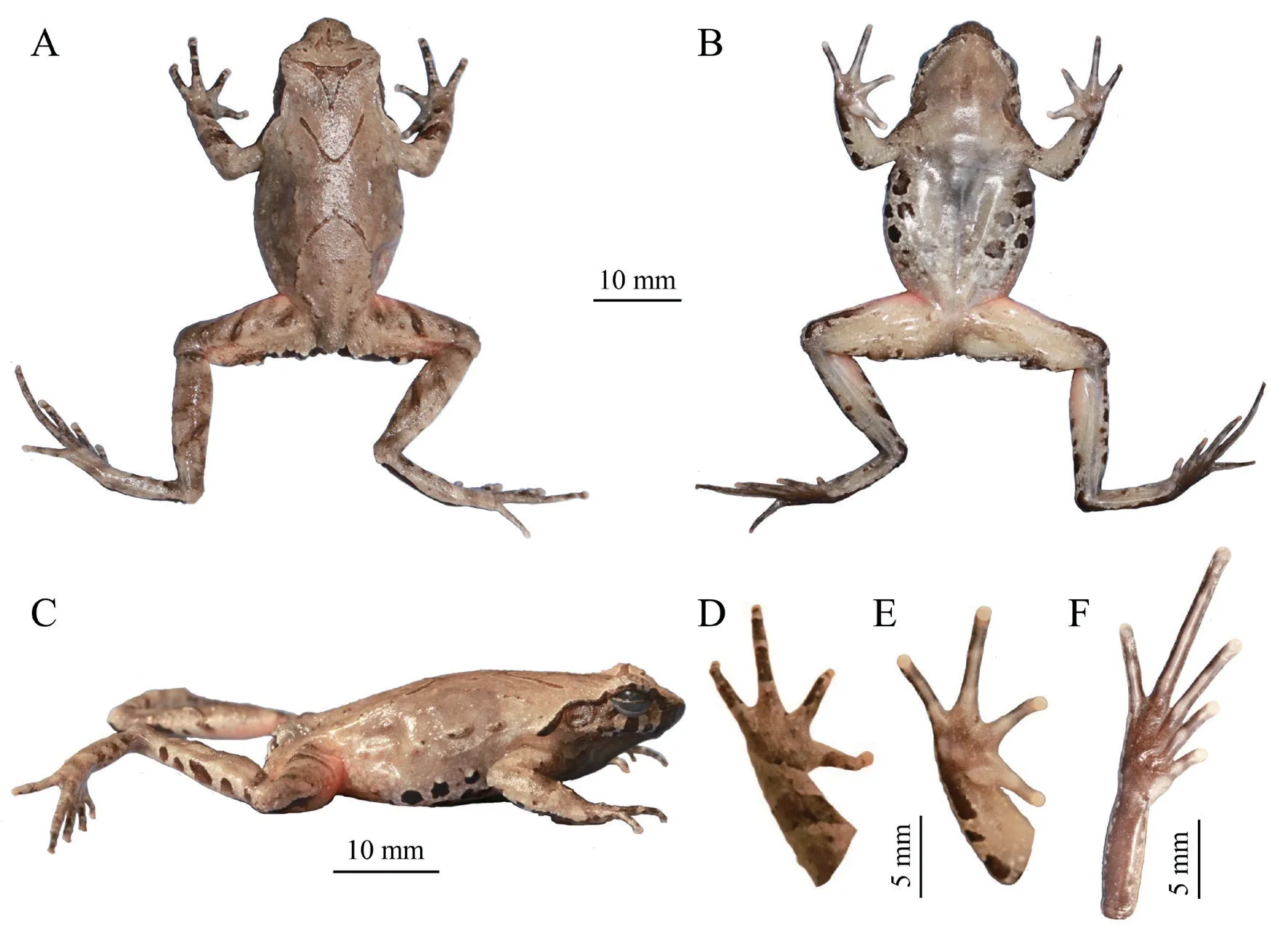
Figure 3 The holotype specimen (CIBKKS20180722006) of Megophrys jiangi sp.nov.A:dorsal view.B:ventral view.C:lateral view.D:dorsal view of hand.E:ventral view of hand.F:ventral view of foot.
Dorsal skin rough,with numerous granules;several large warts scattered on flanks;an small horn-like tubercle at the edge of each upper eyelid;tubercles on the dorsum forming an V-shaped and an inverted V-shaped weak ridge,the V-shaped ridges disconnect;two discontinuous dorsolateral parallel ridges on either side of the V-shaped ridges;an inverted triangular brown speckle between two upper eyelids;the skin of posterior sides of abdomen and inner side of thigh with orange;several tubercles on the flanks and dorsal surface of thighs and tibias and forming three transverse tubercle rows;supratympanic fold distinct (Figure 3A).
Ventral surface smooth;chest gland small and round,closer to the axilla than to midventral line;femoral gland on rear of thigh;posterior end of the body protrudes distinct and appears as an arc-shaped swelling,upper the anal region (Figure 3B).
Coloration of holotype in lifeAn inverted triangular brown speckle between the eyes;two V-shaped ridges on the dorsum of body,three transverse bands on the dorsal surface of the thigh and shank separately;several dark brown and white vertical bars on the lower and upper lip;the venter purple grey,some big dark spots on the ventral surface,ventral surface of limbs with some white spots;the posterior of ventral surface of body,inner of thigh and upper of tibia jacinth;palms and soles uniform purple grey,tip of digits pink;pectoral and femoral glands white (Figure 4A-E).
Preserved holotype colorationDorsal surface dark brown;the inverted triangular brown speckle between the eyes,inverted triangular between eyes,V-shaped ridges on dorsum and transverse bands on limbs and digits distinct;ventral surface greyish white;creamy-white substitutes the pinkish in metatarsal tubercles;the posterior of ventral surface of body,inner of thigh and upper of tibia fade to light red (Figure 3).
VariationMorphometric variations of the new species were small in adults (Table 2 and Table S1).In some adult individuals the marking on back of trunk is irregular like network (Figure 5A);in some adult individuals the marking on back of trunk consists by X-shaped ridge (Figure 5B);the marking on back of trunk consists by X-shaped ridge and the skin rough distinct by numerous granules(Figure 5C);in some adult individuals the whole ventral purplish grey except the posterior belly with white blotches(Figure 5D);in some adult individuals the throat and anterior belly atropurpureus,and some with spots mixed black spots on the posterior belly (Figure 5E);in some adult individuals the ventral surface purple and some with spots mixed purple spots on the belly (Figure 5F).
Advertisement callsThe call description is based on recordings of the holotype CIBKKS20180722006 (Figure 6) from the rock of the streamlet.Each call consists of 7-11 (9 ± 1.5,n=10) notes.Call duration was 2.15-4.15 s(3.23 ± 0.63,n=10).Call interval was 0.38-0.53 s (0.45 ± 0.06,n=9).Each note had a duration of 0.17-0.37 second (0.24 ± 0.05,n=90) and the intervals between notes 0.07-0.23 second (0.14 ±0.05,n=80).Amplitude modulation within note was apparent,beginning with moderately high energy pulses,increasing slightly to a maximum,and then decreasing towards the end of each note.The average dominant frequency was 5838.1 ± 111.1(5662-5995 Hz,n=10).
Tadpole descriptionAll measurements of tadpoles were presented in Table 3.The following tadpole description was based on specimen CIBKKS20180426001 at Stage 26 (Figure 7),the tadpole was confirmed asMegophrysjiangisp.nov.by molecular analyses.Body slender,body and tail yellowbrown;tail height greater than body height;dorsal fin arising,behind the origin of the tail,height near mid-length,tapering gradually to narrow,tip pointed;tail 2.4 times as long as snoutvent length;tail height 16.9% of tail length;body width longer than body height;tail fins lightly colored;eyes large,lateral,interorbital distance is 37.4% of snout-vent length;nostril near eyes;spiracle on the left side of the body and not distinct;oral disk terminal,lips expanded and directed upwardly into a umbelliform oral disk;transverse width of expanded funnel 49.4% of snout-vent length.
Secondary sexual characteristicsAdult females with SVL 39.5-40.4 mm,larger than adult males with 34.4-39.2 mm.Adult males have a single subgular vocal sac.In breeding male,the nuptial pads on the dorsal bases of the first finger and second fingers with black nuptial spines obvious under microscope (Figure 3 D).
Morphological comparisons (Table S5)By having small body size,Megophrys jiangisp.nov.differs fromM.aceras,M.auralensis,M.binlingensis,M.carinense,M.caudoprocta,M.chuannanensis,M.damrei,M.edwardinae,M.feae,M.flavipunctata,M.gigantica,M.glandulosa,M.himalayana,M.intermedia,M.jingdongensis,M.kobayashii,M.lekaguli,M.liboensis,M.ligayae,M.longipes,M.major,M.mangshanensis,M.maosonensis,M.medogensis,M.megacephala,M.omeimontis,M.oreocrypta,M.periosa,M.popei,M.sangzhiensis,M.shapingensis,M.shuichengensis,M.spinataandM.takensisby having small body size(maximum SVL < 42.3 mm in the new species vs.minimum SVL > 45 mm in the latter).By lacking vomerine teeth,Megophrys jiangisp.nov.differs fromM.aceras,M.ancrae,M.carinense,M.baluensis,M.caudoprocta,M.chuannanensis,M.damrei,M.daweimontis,M.dongguanensis,M.fansipanensis,M.flavipunctata,M.glandulosa,M.hoanglienensis,M.himalayana,M.insularis,M.intermedia,M.jingdongensis,M.jinggangensis,M.jiulianensis.M.kobayashii,M.lancip,M.latidactyla,M.lekaguli,M.liboensis,M.ligayae,M.major,M.mangshanensis,M.maosonensis,M.medogensis,M.megacephala,M.montana,M.nasuta,M.nankunensis,M.nanlingensis,M.omeimontis,M.oropedion,M.oreocrypta,M.palpebralespinosa,M.parallela,M.parva,M.periosa,M.popei,M.robusta,M.rubrimera,M.sangzhiensis,M.stejnegeri,M.takensis,M.zhangiandM.zunhebotoensis(vs.present in the latter).
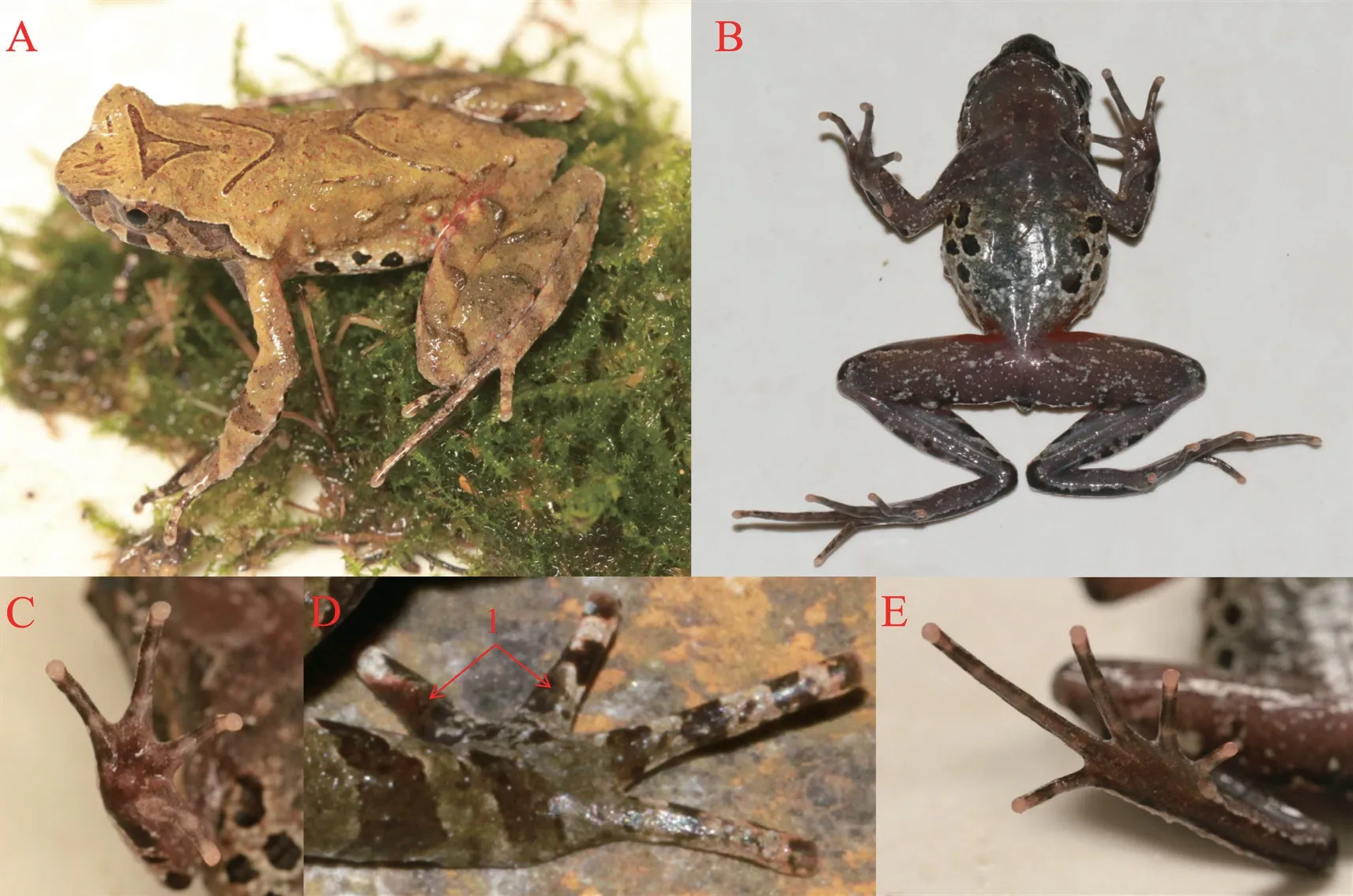
Figure 4 Views of the holotype (CIBKKS20180722006) of Megophrys jiangi sp.nov.in life.A:dorsolateral view.B:ventral view.C:ventral view of hand.D:dorsal view of hand showing nuptial pads on the first and second fingers (1).E:ventral view of foot.

Table 2 Basic statistics for measurements of the adult specimens of Megophrys jiangi sp.nov.Unit:mm.See abbreviations for the morphological characters in Materials and Methods section.

Figure 5 Color variation in Megophrys jiangi sp.nov.in life.A:dorsolateral view of the male specimen CIBKKS20180723001.B:dorsolateral view of the male specimen CIBKKS20180723002.C:dorsal view of the male specimen CIBFJS20150719009.D:ventral view of the female specimen CIBFJS20150718005.E:ventral view of the male specimen CIB FJS20150720004.F:ventral view of the female specimen CIB KKS20180723003.
By having an small horn-like tubercle at the edge of each upper eyelid,Megophrys jiangisp.nov.differs fromM.binchuanensis,M.binlingensis,M.damrei,M.gigantica,M.minor,M.nankiangensis,M.oropedion,M.pachyproctus,M.spinata,M.takensis,M.wuliangshanensis,M.wushanensis,M.zhangiandM.zunhebotoensis(vs.tubercle lacking in the latter).
By having an small horn-like tubercle at the edge of each upper eyelid,Megophrys jiangisp.nov.differs fromM.carinense,M.feae,M.gerti,M.hansi,M.intermedia,M.koui,M.latidactyla,M.liboensis,M.microstoma,M.nasuta,M.palpebralespinosa,M.popei,M.shuichengensis,M.stejnegeriandM.synoria(vs.having a prominent and elongated tubercle at the edge of each upper eyelid in the latter).
By tongue not notched behind,Megophrys jiangisp.nov.differs fromM.ancrae,M.baolongensis,M.binlingensis,M.boettgeri,M.carinense,M.cheni,M.chuannanensis,M.damrei,M.dringi,M.fansipanensis,M.feae,M.feii,M.flavipunctata,M.gerti,M.glandulosa,M.hoanglienensis,M.huangshanensis,M.insularis,M.jiulianensis.M.jingdongensis,M.kuatunensis,M.liboensis,M.mangshanensis,M.maosonensis,M.medogensis,M.minor,M.nankiangensis,M.nanlingensis,M.omeimontis,M.oropedion,M.pachyproctus,M.parallela,M.popei,M.robusta,M.sangzhiensis,M.shapingensis,M.shuichengensis,M.spinata,M.vegrandis,M.wawuensis,M.zhangiandM.zunhebotoensis(vs.tongue notched behind in the latter).
By lacking lateral fringe in toes,Megophrys jiangisp.nov.differs fromM.actuta,M.auralensis,M.baolongensis,M.binchuanensis,M.boettgeri,M.carinense,M.cheni,M.chuannanensis,M.dringi,M.elfina,M.feae,M.feii,M.flavipunctata,M.gigantica,M.glandulosa,M.hansi,M.intermedia,M.jingdongensis,M.jinggangensis,M.kuatunensis,M.latidactyla,M.lini,M.major,M.maosonensis,M.nankiangensis,M.omeimontis,M.palpebralespinosa,M.popei,M.rubrimera,M.sangzhiensis,M.serchhipii,M.shapingensis,M.shuichengensis,M.spinata,M.vegrandis,M.zhangiandM.zunhebotoensis(vs.present in the latter).

Figure 6 Advertisement call of a male Megophrys jiangi sp.nov.,CIBKKS20180722006,holotype.A:waveform showing one syllable.B:sonogram showing one syllable.C:waveform showing nine syllables of one strophe.D:sonogram showing nine syllables of one strophe.

Table 3 Measurements of the tadpoles of Megophrys jiangi sp.nov.Unit:mm.See abbreviations for the morphological characters in Materials and Methods section.
By toes without webs at bases,Megophrys jiangisp.nov.differs fromM.brachykolos,M.carinense,M.flavipunctata,M.jingdongensis,M.jinggangensis,M.lini,M.major,M.palpebralespinosa,M.popei,M.shuichengensis,M.spinata(vs.at least one-fourth webbed in the latter).
By heels overlapping when thighs are positioned at right angles to the body,Megophrys jiangisp.nov.differs fromM.acuta,M.brachykolos,M.dongguanensis,M.nankunensis,M.obesa,M.ombrophilaandM.wugongensisby(vs.heels not meeting when thighs are positioned at right angles to the body in the latter).
By tibiotarsal articulation reaching forward to the region between tympanum and eye when hindlimb is stretched along the side of the body,Megophrys jiangisp.nov.differs fromM.baolongensis,M.nankiangensis,M.pachyproctus,M.shuichengensisandM.tuberogranulatus(vs.reaching posterior corner of the eye in the latter);differs fromM.daweimontis,M.glandulosa,M.lini,M.major,M.medongensis,M.obesa,M.sangzhiensis(vs.reaching the anterior corner of the eye or beyond eye or nostril and tip of snout in the latter);differs fromM.leishanensis(vs.reaching middle part of eye);differs fromM.mufumontana(reaching tympanum in males and to the eye in females).
By having an internal single subgular vocal sac in male,Megophrys jiangisp.nov.differs fromM.caudoprocta,M.shapingensisandM.shuichengensis(vs.vocal sac absent in the latter).
By having nuptial pads and nuptial spines on the dorsal base of the first and second fingers in breeding male,Megophrys jiangisp.nov.differs fromM.acuta,M.feii,M.shapingensisandM.shuichengensis(vs.nuptial pads and nuptial spines lacking in the latter).
Based on molecular phylogenetic analyses,Megophrys jiangisp.nov.was clustered as a sister taxon toM.minor.The new species could be identifiedfromM.minordistinctly by having a small horn-like tubercle at the edge of each upper eyelid (vs.absent in the latter),tongue not notched behind (vs.notched in the latter),tibiotarsal articulation reaching the level between tympanum to eye when leg stretched forward (vs.tibiotarsal articulation reaching the level between eye and tip of snout in the latter),having two or three metatarsal tubercles in each hand (vs.absent of metatarsal tubercle in hand in the latter),and having an small horn-like tubercle at the edge of each upper eyelid (vs.lacking in the latter).
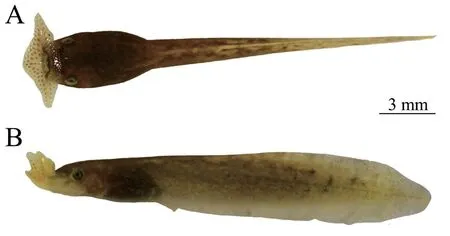
Figure 7 The tadpole of Megophrys jiangi sp.nov.Dorsal view (A)and lateral view (B) of specimen CIBKKS20180426001 in life.
Two speciesofMegophr ys,i.e.M.spinataandM.shuichengensiswere recorded to be sympatric withMegophrys jiangisp.nov.The new species could be identifiedfrom these two species by having small body size(maximum SVL< 42.3 mm in the new species vs.minimum SVL > 45 mm in the latter),tongue not notched behind (vs.notched in the latter),lacking lateral fringe in toes (vs.present in the latter),toes without webs at bases (vs.at least one-fourth webbed in the latter),having an internal single subgular vocal sac in male (vs.nuptial pads and nuptial spines lacking in maleM.shuichengensis),tibiotarsal articulation reaching forward to the region between tympanum and eye when hindlimb is stretched along the side of the body (vs.reaching posterior corner of the eye inM.shuichengensis).
Distribution and habitatsMegophrys jiangisp.nov.is known from the type locality,Kuankuoshui National Nature Reserve (28°06′-28°19′ N,107°02′-107°14′ E),Suiyang county,Fanjing Mountain (27°49′-28°01′ N,108°45′-108°48′ E),Jiangkou County,Guizhou Province,China at elevations between 1 270-1704 m a.s.l.in Kuankuoshui Nature National Reserve and Fanjing Mountain,and from Chenet al.(2017),this new species is also distributed in Jianba Town,Suiyang County,Guizhou Province and Qinghua Forest Farm,Chongqing City,China.
Both in the Kuankuoshui National Nature Reserve and Fanjing Mountain,the new species are frequently found in bamboo forests nearby the streams (Figure 8 A,B),and five sympatric amphibian species,i.e.Megophrys spinata,Odorrana margaratae,Rhacophorus omeimontisandRana zhenhaiensiswere found in the two localities.
EtymologyThe specific epithet“jiangi”is in honor of Professor Jian-Ping Jiang from Chengdu Institute of Biology,Chinese Academy of Sciences,in recognition of his contributions to the systematic studies and biodiversity conservation of amphibians in China.
4.Discussion
In the genusMegophrys,due to the superficial similarities in morphologies (e.g.drab colorations,complicated markings and even changeable colorations and skin markings of the same individual under various environments),related species is often considered to be difficult to be distinguished from each other especially in field identification,which would cause confusion in taxonomic arrangements (Feiet al.,2009).Megophrys minorwas recorded in a wide distributional range in the provinces of Sichuan,Guizhou,Chongqin,Yunnan,Guangxi,Jiangxi in China and north of Vietnam (Feiet al.,2012,2016).The species has been recorded in Kuangkuoshui National Nature Reserve and Fanjing Mountain for many years (Wuet al.,1986;Feiet al.,2012,2016),but we just foundMegophrys jiangisp.nov.in these two regions though with many surveys in recent years.Therefore,we suggested that the populations in these areas ever identified asM.minorwere under misidentification and should beMegophrys jiangisp.nov.In consideration of much underestimated species diversity in the genusMegophryss.l.(Liuet al.,2018),it is expected that there still be cryptic species whose populations had possibly been identified asM.minor,probably corresponding to several cryptic species suggested in Chenet al.(2017) and Liuet al.(2018).This need deep field investigations and comprehensive comparisons in the related regions.
Geographical distances between Kuankuoshui National Nature Reserve and Fanjing Mountain were about 153 km,and the new species is much probably distributed in the region between the two localities.Moreover,in the region between these two localities,just in these two years,our group has described three new frog species,i.e.Megophrys jiangisp.nov.,Microhyla fanjingshanensis(Liet al.,2019) andOdorrana kweichowensis(Liet al.,2018b),and this region was also indicated as the overlap region of many related species and/or clades (Liet al.,2018b).Hence,more detailed investigations will contribute to determining the distribution range of the species and exploring systematic profiles of the related taxa in this region.
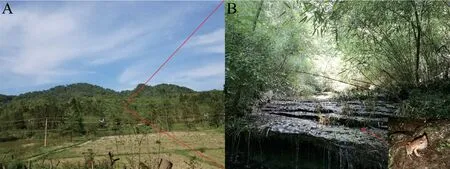
Figure 8 Habitats of Megophrys jiangi sp.nov.in the type locality Kuankuoshui National Nature Reserve,Suiyang County,Guizhou Province,China.A:landscape of montane forests in the type locality.B:a mountain stream in the type locality (insert a male of the new species calling on the stone).
AcknowledgementsWe are grateful to editors and reviewers for their working on the manuscript.Collections in field were permitted by Administration of Kuankuoshui National Nature Reserve (No.KKS20040348).This study was approved by the animal ethical committee of Chengdu Institute of Biology,Chinese Academy of Sciences,and animal experiments were carried out following the institutional guidelines (No.2017CIBAEC0344).This work was supported by Project Supported by the Biodiversity Investigation,Observation and Assessment Program (2019-2023) of Ministry of Ecology and Environment of China,the Strategic Priority Research Program of the Chinese Academy of Sciences (Grant No.XDPB0202),National Natural Sciences Foundation of China (NSFC-31960099),Biodiversity Conservation Key Laboratory of Guizhou Province Education Department,Guiyang College,The laboratory on biodiversity conservation and applied ecology of Guiyang college,Guizhou Provincial Department of Education Youth Science and Technology Talents Growth Project (Nos.KY[2018]455,KY[2018]468 and KY[2018]469),The Specialty Food Resource Utilization Talent Base of Moutai University.
Appendix
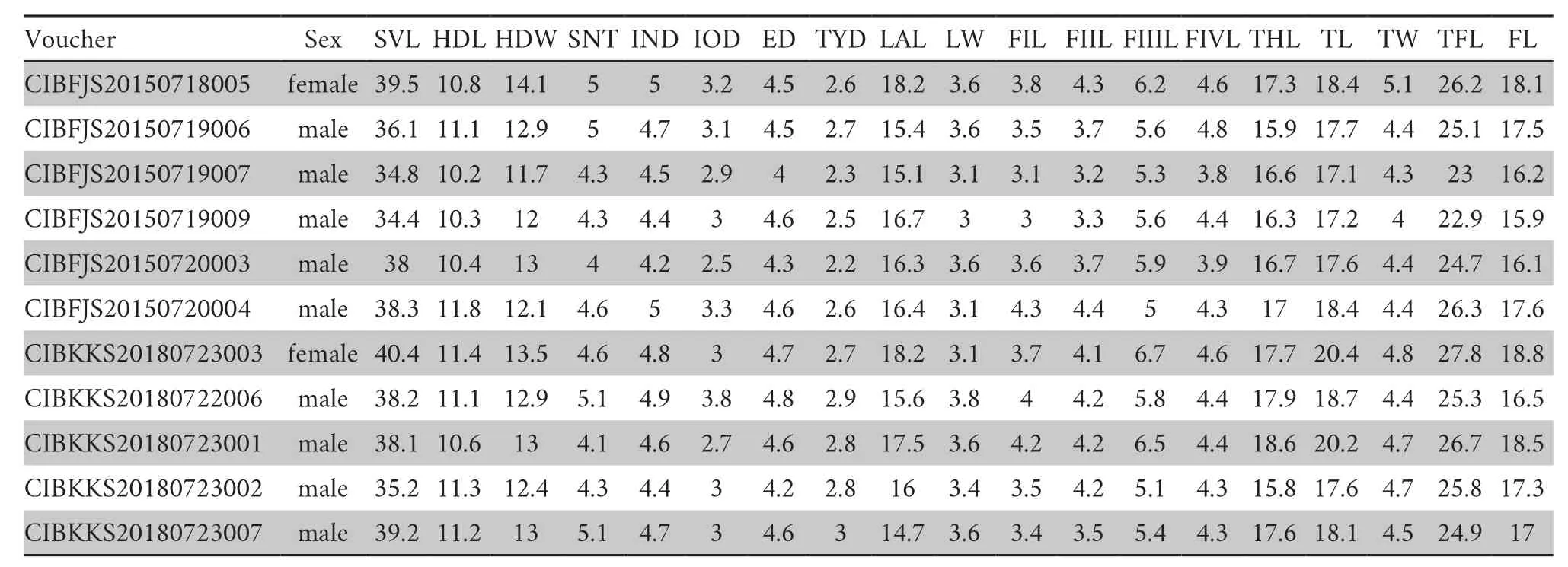
Table S1 Measurements of the adult specimens of Megophrys jiangi sp.nov.Unit:mm.See abbreviations for the morphological characters in Materials and Methods section.

Table S2 Primers used in this study.
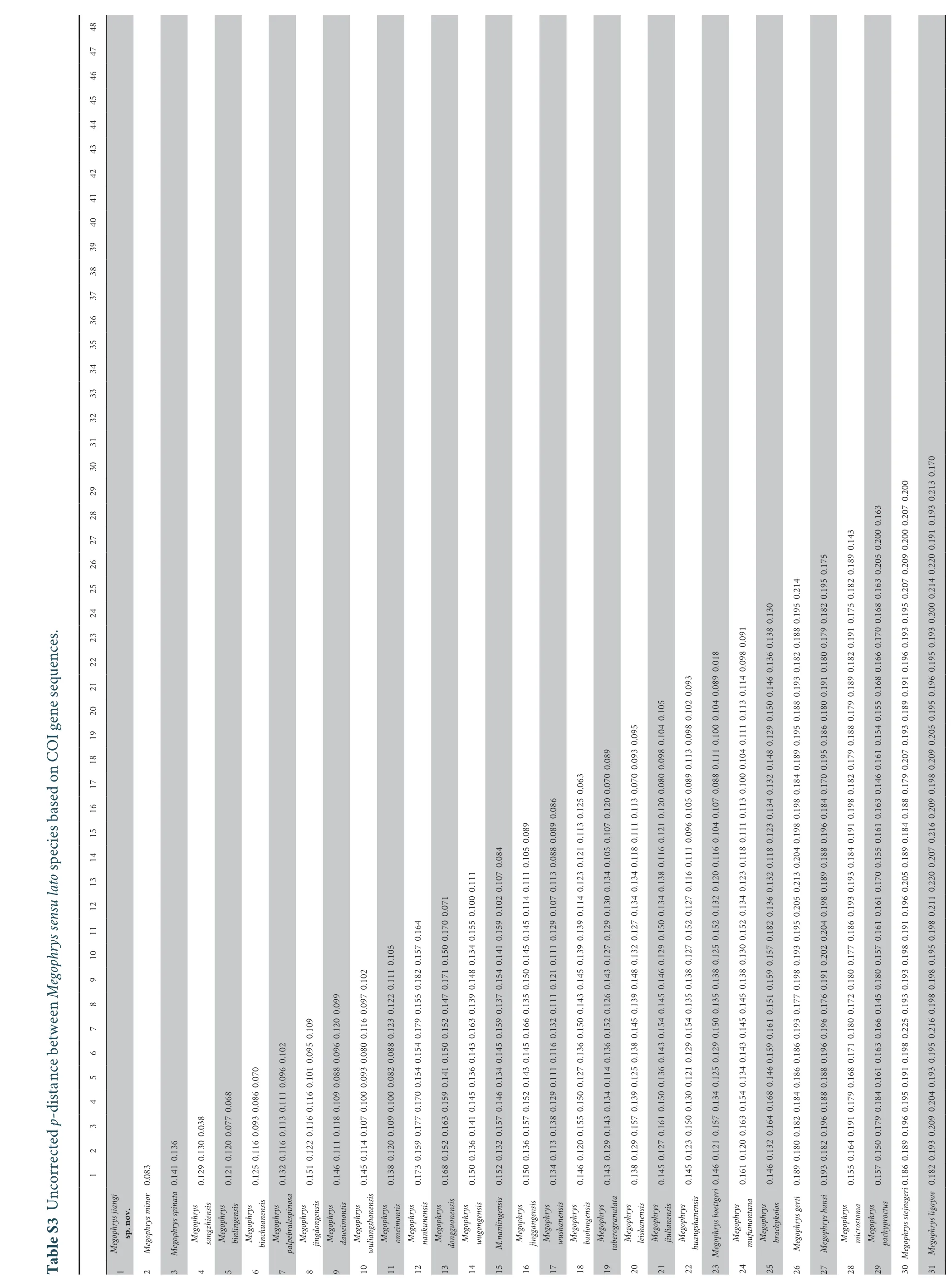

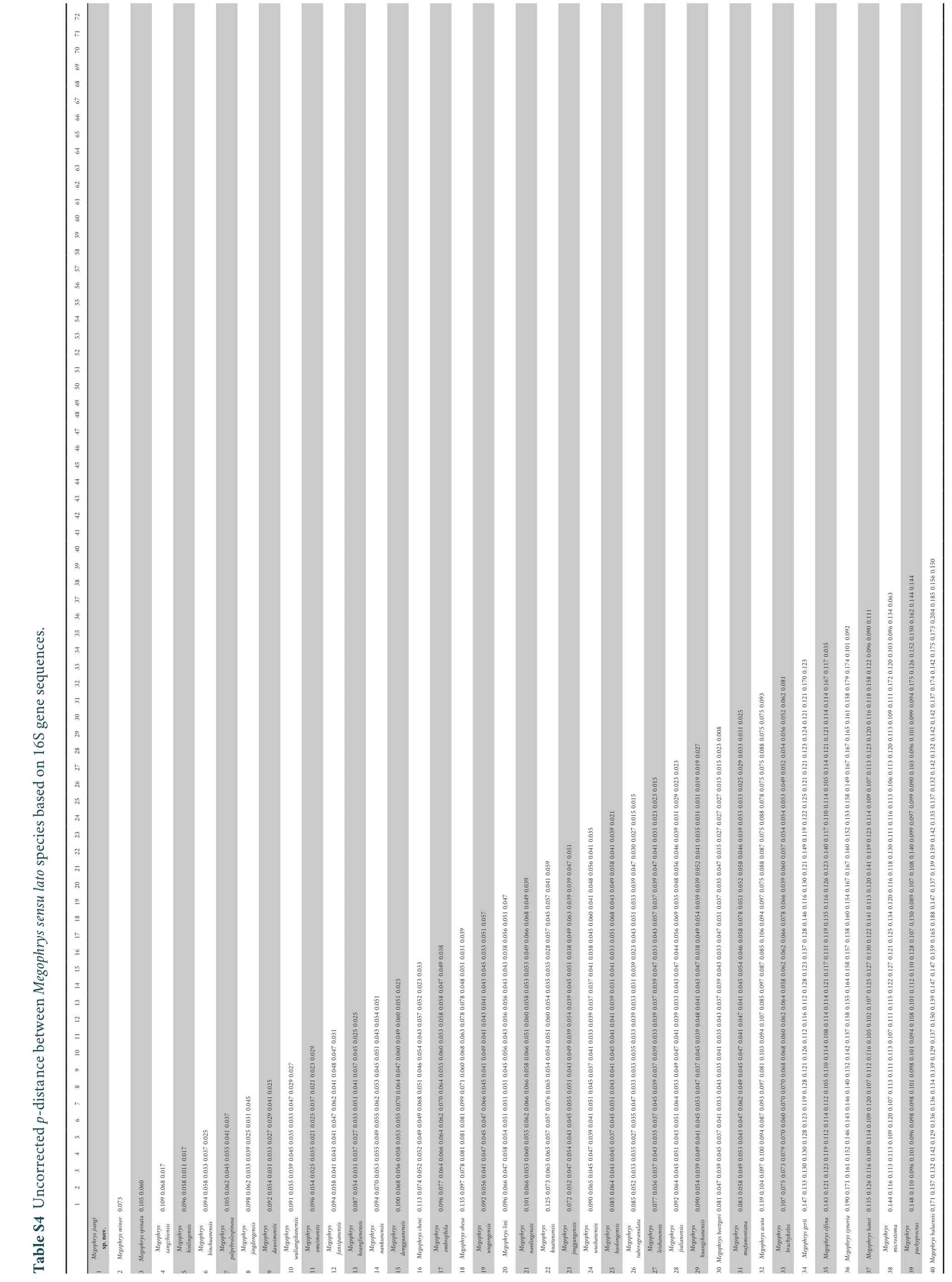


Table S5 Diagnostic characters separating Megophrys jiangi sp.nov.from other 91 species of the Megophrys sensu lato.
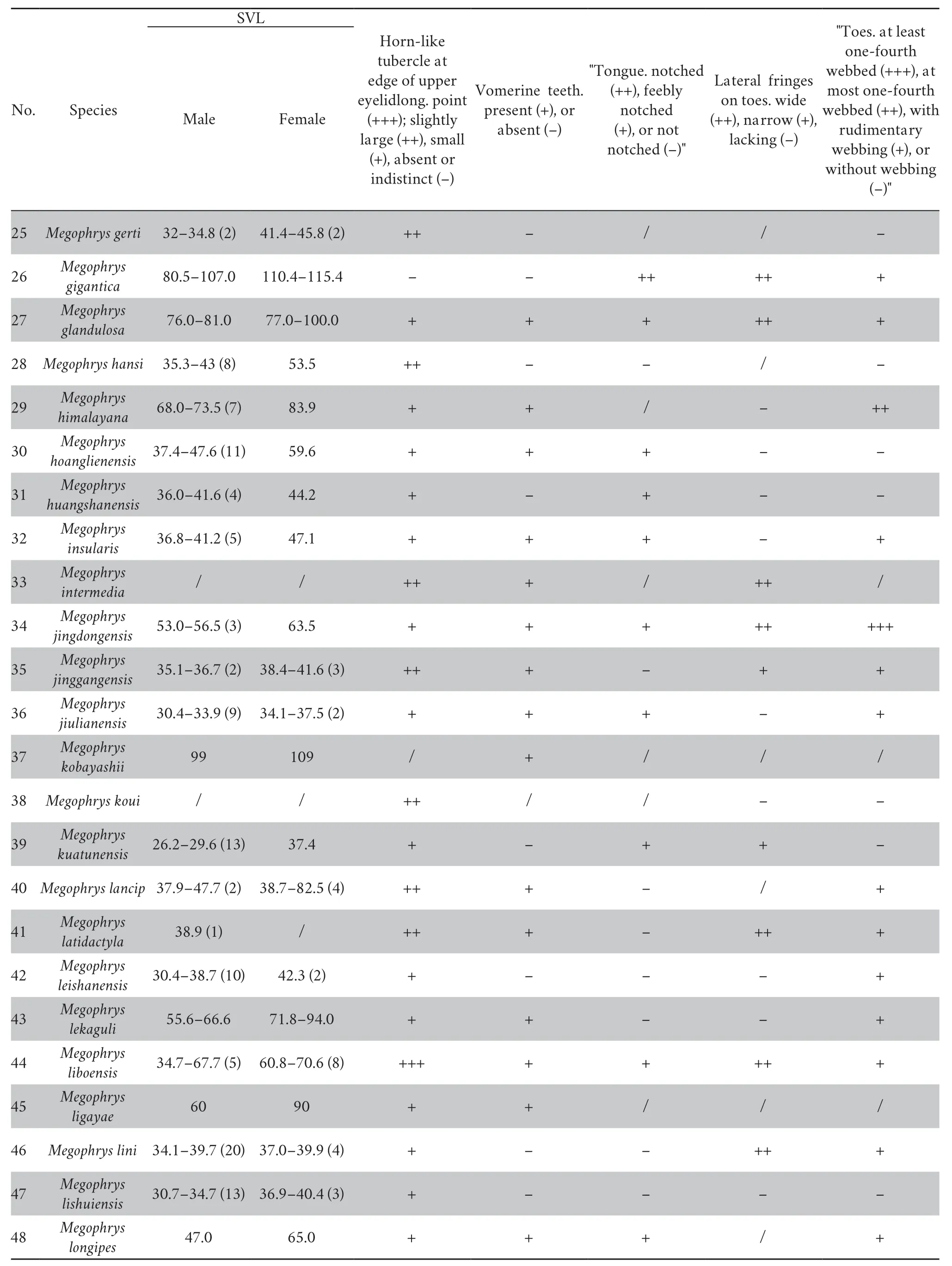
Continued Table S5

Continued Table S5

Continued Table S5
杂志排行
Asian Herpetological Research的其它文章
- Genetic Differentiation of the Forest Crested Lizards,Calotes emma alticristatus Schmidt,1925 and C.emma emma Gray,1845 (Squamata:Agamidae) Relating to Climate Zones in Thailand
- A Revised Checklist of Amphibians and Reptiles in Camiguin Sur,Misamis Oriental,Mindaanao,Philippines
- Species Diversity and Elevational Distribution of Amphibians in the Xianxialing and Wuyishan Mountain Ranges,Southeastern China
- Does Light Exposure during Embryonic Development Affect Cognitive Behavior in a Lizard?
- Changes on Anuran Tadpole Functional Diversity along an Environmental Gradient at the Southernmost Atlantic Rainforest Remnant
